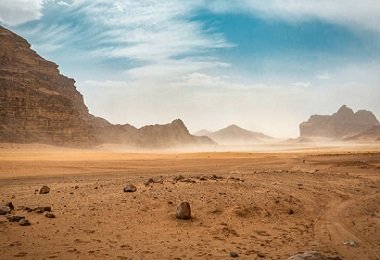See the Hottest Place in the World that you taught Never Existed
Do you know the hottest place in the world? Guess you may be saying the Sahara desert but that guess is as good as wrong. Certainly, The hottest place on Earth is a subject of fascination for many, with extreme temperatures pushing the limits of human endurance and shaping the landscapes in which they occur. Among the contenders for this title, several locations stand out for their scorching temperatures, relentless sunlight, and harsh environments. One such place is the Lut Desert, also known as Dasht-e Lut, located in southeastern Iran. With its record-breaking temperatures and otherworldly terrain, the Lut Desert offers a glimpse into the extremes of our planet's climate. See more details below as I tell you more about this place.

The Lut Desert covers an area of approximately 51,800 square kilometers (20,000 square miles), making it one of the largest deserts in the world. Its name, "Lut," derives from an Arabic word meaning "emptiness," reflecting the stark and desolate nature of this arid landscape. Within its boundaries lies the Lut Desert's most famous feature, the Gandom Beryan plateau, which holds the record for the highest land surface temperature ever recorded on Earth.
It is the world’s 33rd-largest desert, and was included in UNESCO’s World Heritage List on July 17, 2016. The name like i earlier mentioned is derived from “Lut” which means bare and empty in Persian and “dasht” which means plain in Persian.
During the summer months, temperatures in the Lut Desert soar to staggering levels, often exceeding 50 degrees Celsius (122 degrees Fahrenheit). The combination of intense sunlight, minimal cloud cover, and lack of vegetation creates a furnace-like environment where the ground absorbs and radiates heat with exceptional efficiency. In July 2005, NASA's Aqua satellite measured the surface temperature of the Gandom Beryan plateau at a blistering 70.7 degrees Celsius (159.3 degrees Fahrenheit), setting a new world record.
The extreme temperatures of the Lut Desert are the result of several factors, including its location within the subtropical belt, its low elevation, and its unique geological features. Situated between the Zagros Mountains to the west and the Baluchistan Plateau to the southeast, the desert is effectively shielded from maritime influences, leading to hot, dry conditions year-round. Additionally, the desert's vast expanses of sand and rock absorb and retain heat, further intensifying the temperature extremes.
SEE ALSO: A NIGERIAN KING WHO ATE 43 BRITISH HOSTAGE IN 1896
Despite its hostile environment, the Lut Desert is not devoid of life. Some resilient plant and animal species have adapted to survive in this harsh landscape, demonstrating remarkable strategies for coping with extreme heat and aridity. Among them are the Jerboa, a small rodent known for its ability to conserve water and regulate body temperature, and the drought-resistant shrubs and grasses that eke out a living in the desert's sandy soils.
Human presence in the Lut Desert is sparse, limited primarily to nomadic tribes and small settlements scattered throughout the region. These inhabitants have developed traditional methods of survival, relying on livestock herding, subsistence agriculture, and trade to sustain themselves in this challenging environment. However, the harsh climate and lack of resources pose significant challenges to human habitation, leading many to migrate to more hospitable areas in search of better opportunities.
In addition to its extreme temperatures, the Lut Desert is renowned for its otherworldly landscapes, shaped by aeolian processes over millions of years. Wind-blown sand dunes, known as "kaluts," rise and fall across the desert floor, sculpted into intricate shapes and patterns by the prevailing winds. These natural formations create a surreal and ethereal atmosphere, drawing photographers, adventurers, and scientists from around the world to witness their beauty.
The Lut Desert's status as the hottest place on Earth has attracted scientific interest as well, prompting researchers to study its unique climate and geology in search of insights into planetary processes. By analyzing the desert's extreme temperatures, arid conditions, and geological formations, scientists hope to better understand the mechanisms driving climate change and the evolution of terrestrial environments.
Despite its remote location and inhospitable conditions, the Lut Desert continues to captivate the imagination of explorers, scientists, and adventurers alike. Its record-breaking temperatures, otherworldly landscapes, and resilient inhabitants offer a window into the extremes of our planet's climate and the remarkable adaptations of life in the harshest environments. As our understanding of the Lut Desert grows, so too does our appreciation for the complex interplay of forces that shape the natural world and define the limits of human endurance.
Is there any life in the Lut Desert?
The region has been described in the past as a place of “no life” and information on the biological resources in this area is limited. Nevertheless, the property possesses flora and fauna adapted to the harsh conditions including an interesting adapted insect fauna.
Lastly, The Lut Desert's status as one of the hottest and driest places on Earth has made it a subject of scientific interest and research. Scientists study the desert's climate, geology, and ecosystems to gain insights into planetary processes, climate change, and the evolution of terrestrial environments. By understanding the mechanisms driving extreme heat and aridity in the Lut Desert, researchers hope to better predict and mitigate the impacts of climate change on vulnerable regions worldwide.
Despite its extreme conditions, the Lut Desert continues to fascinate and inspire awe in those who venture into its vast expanse. Its record-breaking temperatures, otherworldly landscapes, and resilient inhabitants offer a glimpse into the harsh realities of life in one of the Earth's most extreme environments. As our understanding of the Lut Desert deepens, so too does our appreciation for the beauty, complexity, and fragility of the natural world.
Spread the Word: if you found this article useful, help others discover it too! Just click and share using the buttons below!
What's Your Reaction?




















